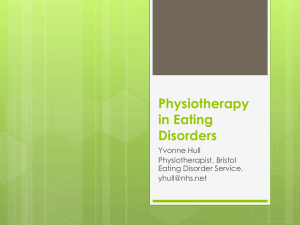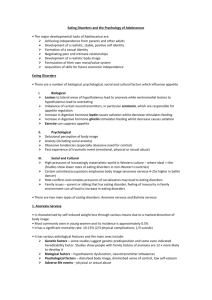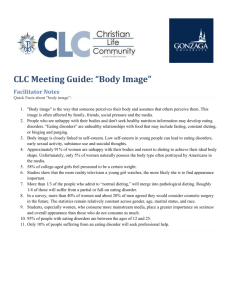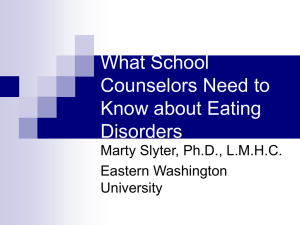Eating Disorders
advertisement
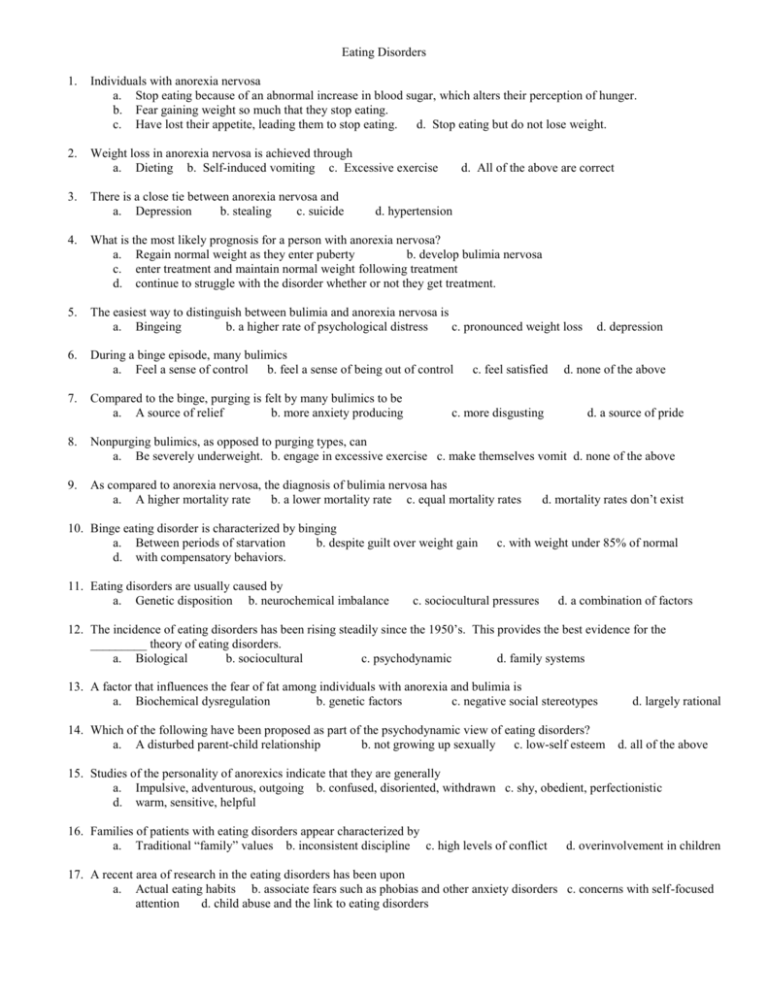
Eating Disorders 1. Individuals with anorexia nervosa a. Stop eating because of an abnormal increase in blood sugar, which alters their perception of hunger. b. Fear gaining weight so much that they stop eating. c. Have lost their appetite, leading them to stop eating. d. Stop eating but do not lose weight. 2. Weight loss in anorexia nervosa is achieved through a. Dieting b. Self-induced vomiting c. Excessive exercise 3. There is a close tie between anorexia nervosa and a. Depression b. stealing c. suicide d. All of the above are correct d. hypertension 4. What is the most likely prognosis for a person with anorexia nervosa? a. Regain normal weight as they enter puberty b. develop bulimia nervosa c. enter treatment and maintain normal weight following treatment d. continue to struggle with the disorder whether or not they get treatment. 5. The easiest way to distinguish between bulimia and anorexia nervosa is a. Bingeing b. a higher rate of psychological distress c. pronounced weight loss 6. 7. During a binge episode, many bulimics a. Feel a sense of control b. feel a sense of being out of control Compared to the binge, purging is felt by many bulimics to be a. A source of relief b. more anxiety producing c. feel satisfied c. more disgusting d. depression d. none of the above d. a source of pride 8. Nonpurging bulimics, as opposed to purging types, can a. Be severely underweight. b. engage in excessive exercise c. make themselves vomit d. none of the above 9. As compared to anorexia nervosa, the diagnosis of bulimia nervosa has a. A higher mortality rate b. a lower mortality rate c. equal mortality rates 10. Binge eating disorder is characterized by binging a. Between periods of starvation b. despite guilt over weight gain d. with compensatory behaviors. 11. Eating disorders are usually caused by a. Genetic disposition b. neurochemical imbalance d. mortality rates don’t exist c. with weight under 85% of normal c. sociocultural pressures d. a combination of factors 12. The incidence of eating disorders has been rising steadily since the 1950’s. This provides the best evidence for the _________ theory of eating disorders. a. Biological b. sociocultural c. psychodynamic d. family systems 13. A factor that influences the fear of fat among individuals with anorexia and bulimia is a. Biochemical dysregulation b. genetic factors c. negative social stereotypes 14. Which of the following have been proposed as part of the psychodynamic view of eating disorders? a. A disturbed parent-child relationship b. not growing up sexually c. low-self esteem d. largely rational d. all of the above 15. Studies of the personality of anorexics indicate that they are generally a. Impulsive, adventurous, outgoing b. confused, disoriented, withdrawn c. shy, obedient, perfectionistic d. warm, sensitive, helpful 16. Families of patients with eating disorders appear characterized by a. Traditional “family” values b. inconsistent discipline c. high levels of conflict d. overinvolvement in children 17. A recent area of research in the eating disorders has been upon a. Actual eating habits b. associate fears such as phobias and other anxiety disorders c. concerns with self-focused attention d. child abuse and the link to eating disorders 18. In the cognitive-behavioral view, the non-eating of anorexics is reinforced by a. Reducing anxiety about being fat b. reducing sexual demands from males family members d. increased time and energy for studies c. attention of overly concerned 19. Positive reinforcement for dieting is sometimes derived from a. A sense of mastery and control associated with dieting b. reduction in hunger as one loses more weight c. attention from others as more weight is lost d. decreased negative body image associated with lower weight 20. Efforts to treat bulimia nervosa using antidepressant drugs have been complicated by a. High numbers of dropouts b. frequent side-effects c. extreme weight gain d. all of the above. 21. What brain structure has been hypothesized to play a role in eating disorders? a. Frontal lobe b. hippocampus c. hypothalamus d. pituitary gland 22. In eating disorders, endogenous opioids a. Are at low levels, leading to a euphoric state b. are likely reinforcing euphoria d. are decreased by purging, leading to euphoria c. are released by purging, leading to 23. The neurotransmitter most closely associated with eating disorders is a. Epinephrine b. dopamine c. opioids d. serotonin 24. Drug treatment of bulimia nervosa is most significantly limited by a. Lack of demonstrated effectiveness of the drugs b. addiction c. dropping out of treatment d. the resulting obesity 25. Studies have shown drug treatment to be a. Effective for bulimics only b. effective for anorexics only d. ineffective for both anorexics and bulimics c. effective for both anorexics and bulimics 26. Family therapy, ala Minuchin, would likely involve a. A “family” lunch session b. modeling appropriate eating patterns during mealtimes d. all of the above c. withholding social contacts except 27. The ultimate goal of Minuchin’s family therapy in treating anorexia is to a. Get the parents to take responsibility for their role in the problem b. redefine the disorder as an interpersonal issue c. force the patient to eat d. quit trying to force their daughter to eat. 28. In the DSM-IV, eating disorders are listed as a. Disorders beginning in childhood or adolescence c. psychological factors affecting medical conditions 29. Anorexia in men is a. Almost non-existent c. is less likely to be fatal than in women b. somatization disorders d. a separate diagnostic category b. is related to less family conflict than in women d. is quiet similar to that in women 30. Which of the following has largely been ruled out as part of the etiology of eating disorders? a. Serotonin b. endogenous opioids c. hypothalamus d. genetic factors



